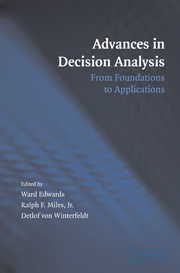Book contents
- Frontmatter
- Contents
- List of Contributors
- Preface
- 1 Introduction
- PART I HISTORY AND FOUNDATIONS OF DECISION ANALYSIS
- 2 The Emergence of Decision Analysis
- 3 The Foundations of Decision Analysis Revisited
- 4 Decision Analysis: A Personal Account of How It Got Started and Evolved
- 5 Reflections on the Contributions of Ward Edwards to Decision Analysis and Behavioral Research
- PART II STRUCTURING DECISION PROBLEMS
- PART III PROBABILITIES AND BAYES NETS
- PART IV UTILITIES
- PART V RISK ANALYSIS
- PART VI DECISION ANALYSIS IN A BEHAVIORAL AND ORGANIZATIONAL CONTEXT
- PART VII APPLICATIONS OF DECISION ANALYSIS
- Index
- References
3 - The Foundations of Decision Analysis Revisited
Published online by Cambridge University Press: 05 June 2012
- Frontmatter
- Contents
- List of Contributors
- Preface
- 1 Introduction
- PART I HISTORY AND FOUNDATIONS OF DECISION ANALYSIS
- 2 The Emergence of Decision Analysis
- 3 The Foundations of Decision Analysis Revisited
- 4 Decision Analysis: A Personal Account of How It Got Started and Evolved
- 5 Reflections on the Contributions of Ward Edwards to Decision Analysis and Behavioral Research
- PART II STRUCTURING DECISION PROBLEMS
- PART III PROBABILITIES AND BAYES NETS
- PART IV UTILITIES
- PART V RISK ANALYSIS
- PART VI DECISION ANALYSIS IN A BEHAVIORAL AND ORGANIZATIONAL CONTEXT
- PART VII APPLICATIONS OF DECISION ANALYSIS
- Index
- References
Summary
ABSTRACT. For centuries people have speculated on how to improve decision making without much professional help in developing clarity of action. Over the last several decades, many important contributions have been integrated to create the discipline of decision analysis, which can aid decision makers in all fields of endeavor: business, engineering, medicine, law, and personal life. Because uncertainty is the most important feature to consider in making decisions, the ability to represent knowledge in terms of probability, to see how to combine this knowledge with preferences in a reasoned way, to treat very large and complex decision problems using modern computation, and to avoid common errors of thought have combined to produce insights heretofore unobtainable. The limitation to its practice lies in our willingness to use reason, rather than in any shortcoming of the field. This chapter discusses the sources of the discipline; the qualities desired in a decision process; the logic for finding the best course of action; the process of focusing attention on important issues in attaining clarity of action; the need for clear and powerful distinctions to guide our thinking (because most decisions derive from thought and conversation rather than from computation); and the challenges to the growth of the discipline.
Introduction
Revisiting the foundations of decision analysis means seeing what those foundations have been, how they have evolved, and how well they will serve in the future.
- Type
- Chapter
- Information
- Advances in Decision AnalysisFrom Foundations to Applications, pp. 32 - 56Publisher: Cambridge University PressPrint publication year: 2007
References
- 42
- Cited by



